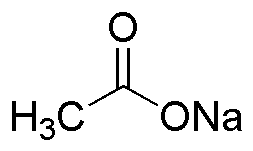Sodium acetate, anhydrous is widely utilized in research focused on:
- Food Preservation: It acts as a food additive, helping to regulate acidity and enhance flavor in processed foods, ensuring longer shelf life.
- Buffer Solutions: Commonly used in laboratories, it helps maintain pH levels in biochemical experiments, providing stability for various reactions.
- Textile Industry: Employed in dyeing processes, it improves the fixation of dyes on fabrics, resulting in vibrant colors and better wash fastness.
- Pharmaceuticals: Utilized in the formulation of certain medications, it aids in drug delivery systems, enhancing the solubility of active ingredients.
- Heating Pads: Its ability to release heat upon crystallization makes it ideal for reusable heating pads, providing a convenient solution for pain relief.
Información general
Propiedades
Seguridad y normativas
Aplicaciones
Sodium acetate, anhydrous is widely utilized in research focused on:
- Food Preservation: It acts as a food additive, helping to regulate acidity and enhance flavor in processed foods, ensuring longer shelf life.
- Buffer Solutions: Commonly used in laboratories, it helps maintain pH levels in biochemical experiments, providing stability for various reactions.
- Textile Industry: Employed in dyeing processes, it improves the fixation of dyes on fabrics, resulting in vibrant colors and better wash fastness.
- Pharmaceuticals: Utilized in the formulation of certain medications, it aids in drug delivery systems, enhancing the solubility of active ingredients.
- Heating Pads: Its ability to release heat upon crystallization makes it ideal for reusable heating pads, providing a convenient solution for pain relief.
Documentos
Hojas de datos de seguridad (HDS)
La SDS proporciona información de seguridad completa sobre la manipulación, el almacenamiento y la eliminación del producto.
Especificación del producto (PS)
La PS proporciona un desglose completo de las propiedades del producto, incluida la composición química, el estado físico, la pureza y los requisitos de almacenamiento. También detalla los rangos de calidad aceptables y las aplicaciones previstas del producto.
Certificados de análisis (COA)
Busque certificados de análisis (COA) ingresando el número de lote del producto. Los números de lote y de partida se pueden encontrar en la etiqueta de un producto después de las palabras "Lote" o "Lote".
Número de catálogo
Número de lote/lote
Certificados de origen (COO)
Este certificado de origen confirma el país en el que se fabricó el producto y también detalla los materiales y componentes utilizados en él y si se deriva de fuentes naturales, sintéticas u otras fuentes específicas. Este certificado puede ser necesario para cumplir con las normativas aduaneras, comerciales y regulatorias.
Número de catálogo
Número de lote/lote
Hojas de datos de seguridad (HDS)
La SDS proporciona información de seguridad completa sobre la manipulación, el almacenamiento y la eliminación del producto.
DownloadEspecificación del producto (PS)
La PS proporciona un desglose completo de las propiedades del producto, incluida la composición química, el estado físico, la pureza y los requisitos de almacenamiento. También detalla los rangos de calidad aceptables y las aplicaciones previstas del producto.
DownloadCertificados de análisis (COA)
Busque certificados de análisis (COA) ingresando el número de lote del producto. Los números de lote y de partida se pueden encontrar en la etiqueta de un producto después de las palabras "Lote" o "Lote".
Número de catálogo
Número de lote/lote
Certificados de origen (COO)
Este certificado de origen confirma el país en el que se fabricó el producto y también detalla los materiales y componentes utilizados en él y si se deriva de fuentes naturales, sintéticas u otras fuentes específicas. Este certificado puede ser necesario para cumplir con las normativas aduaneras, comerciales y regulatorias.


